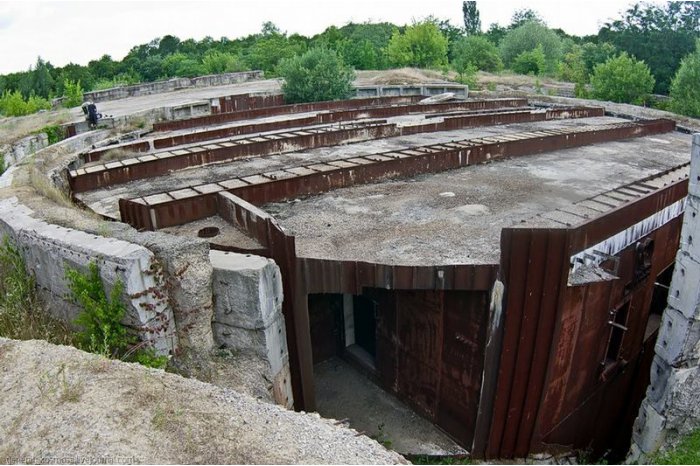
Discover Moldova with #MOLDPRES: story of bad reputation - bunker from Oliscani, one of biggest bunkers from former Soviet Union
The Soviet bunker from the Oliscani village, Soldanesti district
A Soviet underground 13-storied bunker is placed in the forest from the Oliscani village, Soldanesti district. More photos with this construction were posted by a Ukrainian blogger on his Internet page. He writes that such constructions can be found in Russia, Ukraine, Belarus and Azerbaijan.
This bunker is one of the biggest from the former Soviet Union. The construction represents a block with two cylinders with the diameter of 36 metres and the depth of 60 metres.
After the collapse of the Soviet empire, the works were ceased at the construction site of the military base from the Oliscani forest, Soldanesti district, a strategic object of union importance.
How the Oliscani bunker was built?
The construction of the bunker in the Oliscani forest started in the Soviet period and it was a secret object. At that time, the authorities invested about 32 million of Soviet roubles in the construction.
In some 1985, the base, according to information, was almost ready to be made available for use. A reserve command point was deployed there for the general staff of the South-West Direction of the General Staff of the Armed Forces of the Warsaw Treaty.
On the Soviet period, the access to this road, as well as to the wood was strictly banned. Maybe for this reason, the residents of the Oliscani village speak with fear about this construction and even if almost three decades have passed since it was abandoned, people say that they do not know which the mission of the bunker was.
Why the bunker was abandoned?
When the first signals of the USSR’s disintegration appeared, however, the works ceased at the object in the Oliscani forest, where huge sums of public money had been spent. Following the withdrawal of the Soviet troops, the base was abandoned and in 1991, under presidential decree, all weapons, ammunitions, military hardware, military bases and other assets belonging to the units of the Soviet Army deployed in Moldova were declared national heritage.
How the Oliscani bunker looks at present?
All constructions from old times remained just frameworks of two administrative buildings and of a dwelling. Concrete slabs, big stones lie on the well-afforested ground. The area of about 20 hectares is crossed by a lot of trenches.
The bunker is made up of two identical buildings made of concrete and steel with the diameter of 36 metres, which go underground to a distance of about 60 metres or 12 stories. These two bunkers are connected through a framework of tunnels.
It is known that there are similar constructions in Ukraine, Russia, Azerbaijan and Belarus.
How can one get to the Oliscani bunker?
According to the website www.descopera.md, a mini-bus can be taken from the North Bus Terminal to Soldanesti and then to the Oliscani village.
„From there, you can make a walk in the village and then in the wood (there are several paths, which might help you).
Or, if you travel by car, follow the GPS, and when you corner from the main road to the left (the road which leads to the forest), go the next 100 metres and then stop on the right side. It might be necessary that you go to the site by foot.
The problem is the road from the wood, which is made up of three concrete slabs and after the first 100 metres the middle line of the concrete lacks, resulting in a big problem for moving further by car. Besides, the branches will be a problem too,’’ according to www.descopera.md.
Correspondent: Lilia Grubii
Discover Moldova with #MOLDPRES: Constantin Stamati's mansion from Ocnita, journey into 19th century Moldova
Discover Moldova with #MOLDPRES: Goian – village where tradition meets nature and authentic tourism
Editor-in-Chief of National Geographic Polska explores Moldova
Discover Moldova with #MOLDPRES: Ivancea village, one of most picturesque and historically rich places
Discover Moldova with #MOLDPRES: GurmanIA Festival in Tarigrad, Drochia - deep roots, authentic flavors, vibrant traditions
Discover Moldova with #MOLDPRES: The Charm of Dniester – an ecotourism route connecting people with nature, local community
National programme Eco-Tourism Compass launched at Casa din Luncă in central Moldova village
Discover Moldova with #MOLDPRES: Stoianovca from Cantemir district - corner of Bulgarian authenticity, new emerging gastro-tourist route
Discover Moldova with #MOLDPRES: "SânzIEne Unghenene" on Delia Lake Island, a holiday uniting around traditions
Moldovan parliament approves establishment of 12 standing commissions of XIIth legislature
Territorial reform, local autonomy under spotlight of Council of Europe; recommendations for Moldova
Members of standing bureau held first meeting
President at Paris Peace Forum: Social media platforms – once promise of freedom and transparency – have become vast spaces of manipulation
High-level dialog on finance and economic growth held in Chisinau
Implementation of new Forestry Code and environmental legislation under focus of prosecutors and judges
MOLDPRES REPORT // Friendship, respect, partnership: 102 years since proclamation of the Republic of Turkey celebrated in Chisinau
Moldovan president's speech at Paris Peace Forum
Moldovan president meets PM of Armenia
Moldovan president says Kremlin used disinformation at parliamentary elections, so as to undermine trust in free voting, subsequently seize power in Moldova
PHOTO GALLERY // Consultations at Moldovan parliament; PM-designate discusses with parliamentary factions' representatives
Moldovan president at Paris Peace Forum says Europe must grow - EU enlargement not act of charity, but of security
Sanctions on LUKOIL do not affect aircrafts' refueling in Chisinau at present
PM-designate says had constructive consultations with parliamentary factions, to analyze proposals made
EU Parliament's Office in Chisinau to be inaugurated on November 7; European Parliament president to attend event
National Energy Regulatory Agency's leadership, U.S. Embassy's representatives analyze identifying alternative sources, routes for supplying Moldova with oil products

